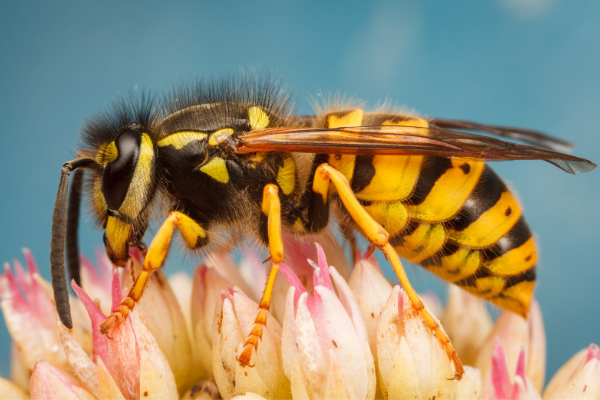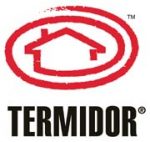 Yellowjacket or yellow jacket is the common name in North America for predatory social wasps of the genera Vespula and Dolichovespula. Members of these genera are known simply as “wasps” in other English-speaking countries. Most of these are black and yellow like the eastern yellowjacket Vespula maculifrons and the aerial yellowjacket Dolichovespula arenaria; some are black and white like the bald-faced hornet, Dolichovespula maculata. Others may have the abdomen background color red instead of black. They can be identified by their distinctive markings, their occurrence only in colonies, and a characteristic, rapid, side-to-side flight pattern prior to landing. All females are capable of stinging. Yellowjackets are important predators of pest insects.
Yellowjacket or yellow jacket is the common name in North America for predatory social wasps of the genera Vespula and Dolichovespula. Members of these genera are known simply as “wasps” in other English-speaking countries. Most of these are black and yellow like the eastern yellowjacket Vespula maculifrons and the aerial yellowjacket Dolichovespula arenaria; some are black and white like the bald-faced hornet, Dolichovespula maculata. Others may have the abdomen background color red instead of black. They can be identified by their distinctive markings, their occurrence only in colonies, and a characteristic, rapid, side-to-side flight pattern prior to landing. All females are capable of stinging. Yellowjackets are important predators of pest insects.
Yellowjackets may be confused with other wasps, such as hornets and paper wasps such as Polistes dominula. A typical yellowjacket worker is about 12 mm (0.5 in) long, with alternating bands on the abdomen; the queen is larger, about 19 mm (0.75 in) long (the different patterns on their abdomens help separate various species).
Yellowjackets are sometimes mistakenly called “bees” (as in “meat bees”), given that they are similar in size and general coloration to honey bees, but yellowjackets are actually wasps. In contrast to honey bees, yellowjackets have yellow or white markings, are not covered with tan-brown dense hair on their bodies, and do not have the flattened, hairy pollen-carrying hind legs characteristic of honey bees (although they are capable of pollination).
Yellowjackets have lance-like stingers with small barbs, and typically sting repeatedly, though occasionally a stinger becomes lodged and pulls free of the wasp’s body; the venom, like most bee and wasp venoms, is primarily dangerous to only those humans who are allergic or are stung many times. All species have yellow or white on their faces. Their mouthparts are well-developed with strong mandibles for capturing and chewing insects, with probosces for sucking nectar, fruit, and other juices. Yellowjackets build nests in trees, shrubs, or in protected places such as inside man-made structures, or in soil cavities, tree stumps, mouse burrows, etc. They build them from wood fiber they chew into a paper-like pulp. Many other insects exhibit protective mimicry of aggressive, stinging yellowjackets; in addition to numerous bees and wasps (Müllerian mimicry), the list includes some flies, moths, and beetles (Batesian mimicry).
Yellowjackets’ closest relatives, the hornets, closely resemble them but have larger heads, seen especially in the large distance from the eyes to the back of the head.
Life cycle and habits
Yellowjackets are social hunters living in colonies containing workers, queens, and males (drones). Colonies are annual with only inseminated queens overwintering. Fertilized queens are found in protected places such as in hollow logs, in stumps, under bark, in leaf litter, in soil cavities, and in man-made structures. Queens emerge during the warm days of late spring or early summer, select a nest site, and build a small paper nest in which they lay eggs. After eggs hatch from the 30 to 50 brood cells, the queen feeds the young larvae for about 18 to 20 days. Larvae pupate, then emerge later as small, infertile females called workers. Workers in the colony take over caring for the larvae, feeding them with chewed up meat or fruit. By midsummer, the first adult workers emerge and assume the tasks of nest expansion, foraging for food, care of the queen and larvae, and colony defense.
From this time until her death in the autumn, the queen remains inside the nest, laying eggs. The colony then expands rapidly, reaching a maximum size of 4000 to 5000 workers and a nest of 10,000 to 15,000 cells in late summer. The species V. squamosa, in the southern part of its range, may build much larger perennial colonies populated by dozens of queens, tens of thousands of workers, and hundreds of thousands of cells. At peak size, reproductive cells are built with new males and queens produced. Adult reproductives remain in the nest fed by the workers. New queens build up fat reserves to overwinter. Adult reproductives leave the parent colony to mate. After mating, males quickly die, while fertilized queens seek protected places to overwinter. Parent colony workers dwindle, usually leaving the nest to die, as does the founding queen. Abandoned nests rapidly decompose and disintegrate during the winter. They can persist as long as they are kept dry, but are rarely used again. In the spring, the cycle is repeated; weather in the spring is the most important factor in colony establishment.
The diet of the adult yellowjacket consists primarily of items rich in sugars and carbohydrates, such as fruits, flower nectar, and tree sap. Larvae feed on proteins derived from insects, meats, and fish. Workers collect, chew, and condition such foods before feeding them to the larvae. Many of the insects collected by the workers are considered pest species, making the yellowjacket beneficial to agriculture. Larvae, in return, secrete a sugary substance for workers to eat; this exchange is a form of trophallaxis. As insect sources of food diminish in late summer, larvae produce less for workers to eat. Foraging workers pursue sources of sugar outside the nest including ripe fruits and human garbage.
Source: Wikipedia





